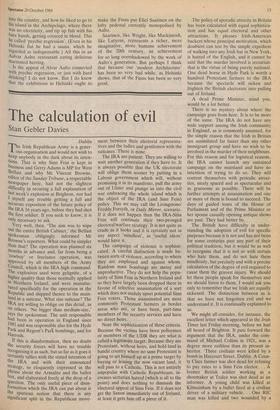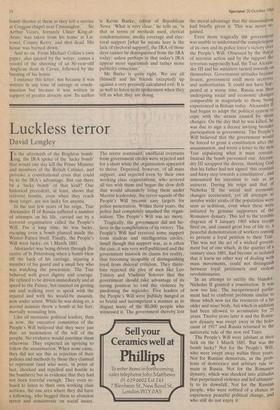The calculation of evil
Stan Gebler Davies
The Irish Republican Army is a gener- ous organisation and would not wish to keep anybody in the dark about its inten- tions. That is why Sinn Fein is kept in business and Gerry Adams is MP for West Belfast and why Mr Vincent Browne, editor of the Sunday Tribune, a respectable newspaper here, had not the slightest difficulty in securing a full explanation of last week's explosion at Brighton, nor had I myself any trouble getting a full and accurate exposition of the future policy of the IRA 16 years ago, before they had shot the first soldier. If you seek to know, it is Only necessary to ask.
Very well, then. 'The aim was to wipe out the entire British Cabinet,' the Belfast spokesman obligingly informed Mr Browne's reporters. What could be simpler than that? The operation was planned six months in advance and, far from being a Cowboy' or freelance operation, was approved by all members of the Army Council, which is the IRA high command. The explosives used were gelignite, of a higher quality than those normally applied in Northern Ireland, and were manufac- tured specifically for the operation in the Republic and shipped thence to the main- land in a suitcase. What size suitcase? The IRA are willing to oblige on this detail, as On others. 'No bigger than medium-size,' says the spokesman. The unit responsible had been in operation in England since 1981 and was responsible also for the Hyde Park and Regent's Park bombings, and for Harrods.
If this is disinformation, then no doubt the security forces will have no trouble recognising it as such, but so far as it goes it certainly tallies with the stated intention of the IRA and with their announced strategy, so eloquently expressed in the phrase about the Armalite and the ballot box, and elaborated freely at the drop of a question. The only useful piece of disin- formation which the IRA can put about is the spurious notion that there is any significant split in the Republican move-
ment between their electoral representa- tives and the ladies and gentlemen with the suitcases. There is none.
The IRA are patient. They are willing to wait another generation if they have to. It is always possible that the UK electorate will oblige them sooner by putting in a Labour government which will, without promising it in its manifesto, pull the army out of Ulster and plunge us into the civil war embracing the whole island which is the object of the IRA (and Sinn Fein) policy. This we may call the Livingstone/ Freddy Forsyth, or Daily Mirror, scenario. If it does not happen then the IRA-Sinn Fein will continute their two-pronged electoral/warfare strategy. It is not quite as crude as it looks and it is certainly not in any aspect 'mindless', as 'useful idiots' would have it.
The campaign of violence is sophisti- cated. A careful distinction is made be- tween sorts of violence, according to where they are employed and against whom. Random mass bombings are messy and unproductive. They do not help the popu- larity of Sinn Fein in Northern Ireland and so they have largely been dropped there in favour of selective assassination of a sort which does not unduly upset potential Sinn Fein voters. Those assassinated are most commonly Protestant farmers in border areas who are, or have been, part-time members of the security services and have no direct heirs.
Note the sophistication of these criteria. Because the victims have been policemen or members of the UDR they are what is called a legitimate target. Because they are Protestant, without heirs, and hold land in bandit country where no sane Protestant is going to set himself up as a prime target by buying or leasing the now vacant land, it will pass to a Catholic. This is not entirely unpopular with Catholic Republicans, in- creases sectarian hatred (which is all to the point) and does nothing to diminish the electoral appeal of Sinn Fein. If it does not get the Saxon immediately out of Ireland, at least it gets him off a piece of it. The policy of sporadic atrocity in Britain has been calculated with equal sophistica- tion and has equal electoral and other attractions. It pleases Irish-American backers whose principal motivation, which doubters can test by the simple expedient of walking into any Irish bar in New York, is hatred of the English, and it cannot be said that the murder involved is sectarian: that is the virtue of being purely national. One dead horse in Hyde Park is worth a hundred Protestant farmers to the IRA because the spectacle will sicken and frighten the British electorate into pulling out of Ireland.
A dead Prime Minister, mind you, would be a lot better.
There is no mystery about where the campaign goes from here. It is to be more of the same. The IRA do not have any wide support among the Irish community in England, as is commonly assumed, for the simple reason that the Irish in Britain are assimilated far faster than any other immigrant group and have no wish to be involved in the murder of their neighbours. For this reason and for logistical reasons, the IRA cannot launch any sustained campaign on the mainland and have no intention of trying to do so. They will content themselves with periodic atroci- ties, nicely spaced and as spectacular and as gruesome as possible. There will be further attempts at assassination and one or more of them is bound to succeed. The days of guided tours of the House of Parliament and of the Prime Minister or her spouse casually opening antique shows are past. They had better be.
The British have difficulty in under- standing the adoption of evil for specific purposes because it is not and has not been for some centuries past any part of their political tradition, but it would be as well to recognise that it is not so with certain who hate them, and do not hate them mindlessly, but precisely and with a precise calculation of the degree of evil required to cause them the gravest injury. We should let these people speak for themselves and we should listen to them. I would ask you only to remember that we Irish are equally sickened. The distinction between us is that we have not forgotten evil and we understand it. It is continually explained to us.
We might all consider, for instance, the excellent letter which appeared in the Irish Times last Friday morning, before we had all heard of Brighton. It puts forward the argument that the IRA, under the com- mand of Michael Collins in 1921, was a degree more ruthless than its present in- heritor. 'Three civilians were killed by a bomb in Harcourt Street, Dublin. A Coun- ty Clare farmer was shot dead for refusing to pay rates to a Sinn Fein elector. . . A former British soldier working as a shoemaker at Tralee was shot dead as an informer. A young child was killed at Kilmainham by a bullet fired at a civilian driver of a military vehicle. . . One RIC man was killed and two wounded by a
bomb thrown at them as they left a service at Creggan chapel near Crosmaglen. . . Sir Arthur Vicars, formerly Ulster King-at- Arms, was taken from his home at Lis- towel, County Kerry, and shot dead. His house was burned down.'
And so on. From Michael Collins's own paper, also quoted by the writer, comes a record of the shooting of an 80-year-old Anglican dean in Cavan, followed by the burning of his house.
I instance this letter, not because it was written in any tone of outrage or conde- mnation but because it was written in support of greater atrocity now. Its author
is Kevin Burke, editor of Republican News. 'What is very clear,' he tells us, 'is that in terms of methods used, clerical condemnations, media coverage and elec- toral support [what he means here is the lack of electoral support], the IRA of those days cannot be distinguished from the IRA today; unless perhaps in that today's IRA appear more squeamish and rather more publicity-conscious.'
Mr Burke is quite right. We are all (himself and his friends excepted) up against a very precisely calculated evil. It is as well to listen to its spokesmen when they tell us what they are doing.



















































 Previous page
Previous page